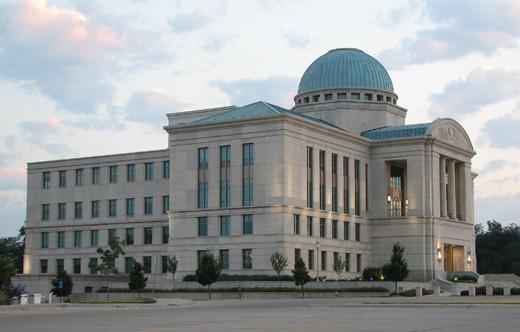First-person accounts of politically-oriented events are always welcome here. Thanks to IowaBadger for this perspective. -promoted by desmoinesdem
Chief Justice Mark Cady’s leadership of the Iowa Supreme Court has been bookended by two major cases. First came his unanimous majority opinion in the Varnum v. Brien decision recognizing marriage equality under the Iowa Constitution, resulting in the defeat of then Chief Justice Marsha Ternus (and two other justices) in the 2010 retention election, and Cady’s elevation to Chief Justice. Then, several weeks ago, was his 4-3 majority opinion in Griffin v. Pate, deciding that the Iowa Constitution’s prohibition against voting by anyone who has committed an “infamous crime” bars anyone with a felony conviction from voting, absent a restoration of voting rights from the governor.
Yesterday, the Des Moines Register held an event entitled “The Cady Court At Five,” which gave five panelists the opportunity to talk about both cases, and how the court has gotten from one to the other. Anyone hoping for post July 4th fireworks would have been disappointed, and anyone hoping for definitive answers will have to heed desmoinesdem’s post from yesterday recognizing that we will only understand Justice Cady’s rationale for his vote in Griffin and its seeming inconsistency with his previous opinion in Chiodo v. Panel when he’s interviewed about it years down the road. But for those of us who follow the Iowa Supreme Court closely, we did gain some insight into the Chief Justice’s thinking and what that might mean for future decisions.
Panelists Ryan Koopmans of Nyemaster Goode and Todd Pettys of the University of Iowa both noted that the pre-2010 retention election Iowa Supreme Court typically acted unanimously or close to it, with dissenting opinions, especially strong ones on consequential issues, being extremely rare. Indeed, as both pointed out, while the Varnum decision was undoubtedly politically controversial, from a legal standpoint it was a unanimous decision. But after Governor Terry Branstad appointed three new justices in 2011, the number of dissents has grown from approximately 10 per year to 30 per year; a significant difference for a court that issues around 85 decisions annually.
Koopmans and Pettys felt that this is significant for Chief Justice Cady, who prides himself on consensus but more and more is becoming the deciding vote in 4-3 cases – a vote that he sometimes uses to vote with the “liberal” bloc of justices, and other times with the “conservative” bloc. I think they are right; the trick is to try and understand what might make him go either way. Pettys noted that a desire for consensus leads the Chief Justice to be a minimalist – going no further than necessary in issuing a ruling. Under that logic, he perhaps did not strike down felon disenfranchisement in the Griffin case because people with felony convictions can still vote if the governor restores their rights. But this seems like a stretch to me – facts before the Chief Justice showed that tens of thousands of Iowans with felony convictions cannot vote, while only about 19 people a year have had their rights restored by Governor Branstad.
Much of the rest of the conversation touched on issues of transparency, a topic of critical importance to anyone covering the Iowa Supreme Court. Panelist Rox Laird, formerly of the Register, noted that one reaction by the Chief Justice to the 2010 retention election was to take the court on the road – holding oral arguments in communities around the state and having the justices visit schools in those communities to educate students about the court and its role. In addition, the court’s arguments are live-streamed online, and archieved on YouTube for later viewing.
On the other hand, as Sarah Boden from Iowa Public Radio and Grant Rodgers of the Register noted, briefs and other documents filed in Iowa Supreme Court cases are currently only available online to Iowa attorneys. They, as reporters, or any member of the general public, must either go to the Iowa Supreme Court building or get the briefs from one of the parties. This is true even though all of these briefs are public records. Panelists noted and seemed satisfied with statements from court personnel that the court is working to fix this.
I think this is generous. In the year 2016, websites are not overly costly to maintain. If case materials can be maintained online in a manner that’s accessible to lawyers, there should be a way to make them accessible to anyone who wants to see them. Not doing this inhibits the media’s ability to do their jobs, and it’s worse for private citizens – media at least can typically ask the parties to voluntarily provide briefs, and report any lack of cooperation if they decline. We should expect the judiciary to be as transparent as the legislature, which posts bills and other materials online, and to get there quickly.
So where do things go from here? Incrementalism may have been the word of the day. We may not know exactly what Chief Justice Cady will do in future controversial cases, but we know that he will continue to seek consensus on the court – even if that results in decisions on very narrow grounds, and we know that where consensus isn’t present, the Chief Justice may be leery of going out on a limb. What we don’t know is the impact of retention elections – did the 2010 election contribute to Cady’s caution, and will his likely 2016 retention embolden him, since he will likely not face the voters again before reaching the age of mandatory retirement. If I had to guess, though, civil liberties and civil rights litigants beware – you may secure a surprising win at the Iowa Supreme Court, but maintaining the status quo seems far more probable.

